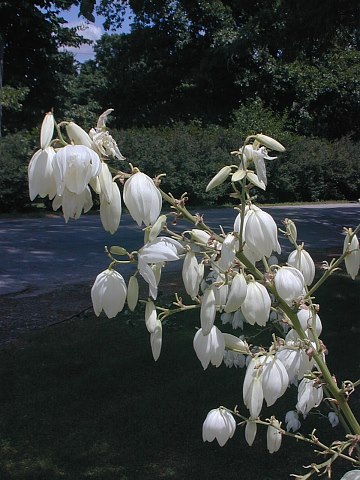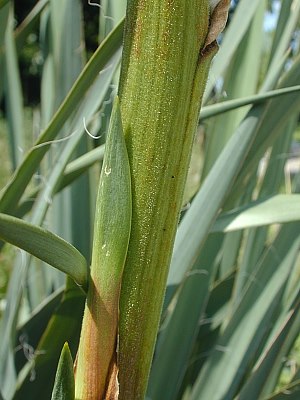Description: This evergreen perennial plant has a large rosette of evergreen basal leaves that spread outward in all directions. Individual basal leaves are up to 30" long and 2" across; they are blue-gray or green-gray and linear in shape with sharp tips. Except for occasional thread-like fibers, the leaf margins are entire (smooth, rather than serrated). Because of their stiff texture, the basal leaves are normally straight, but sometimes they bend downward around the middle. From the middle of the rosette, one or more flowering stalks are produced that are 5-8' tall. These stalks are more or less erect, but occasionally they fall over from a wind storm or some other reason. The central stalk of the inflorescence is dull light green, slightly pubescent, and rather stout; except for a few leafy bracts, it is largely naked. The bracts are nearly appressed against the stalk and quite small in size.

The inflorescence
consists of a large panicle of flowers that is typically about 3' long
and 1½' across. The lateral branches of the panicle are ascending to
widely spreading; like the central stalk, they are dull light green and
slightly pubescent. The flowers hang downward from the lateral branches
on short stout pedicels. Individual flowers are about 2½" and 1"
across, consisting of 6 white tepals, 6 white stamens, and a pistil
with central white style. The reproductive organs are hidden within the
bell-shaped corolla of the flower. The showy tepals are ovate in shape
with glossy surfaces. The blooming period occurs during early to
mid-summer and lasts about 3 weeks. There is a strong and pleasant
floral fragrance. Those flowers that are successfully fertilized
develop light green seedpods about 2½" long and 1" across. Each seed
pod has a short-cylindrical in shape and it is 3-celled. At maturity,
the seedpods become nearly black and divide into 3 parts, releasing
their seeds. Within each cell, the rather large seeds are stacked
together in a column. Each seed is black, somewhat flattened, and more or less round in
circumference. This plant reproduces by reseeding itself and by forming
vegetative offsets from the rosette of basal leaves. In time, these
offsets form their own rosettes of basal leaves. The root system
consists of an underground caudex with fibrous roots.
seed is black, somewhat flattened, and more or less round in
circumference. This plant reproduces by reseeding itself and by forming
vegetative offsets from the rosette of basal leaves. In time, these
offsets form their own rosettes of basal leaves. The root system
consists of an underground caudex with fibrous roots.
Cultivation:
The preference is full sun, mesic to dry conditions, and sandy soil.
However, other kinds of soil are tolerated as well, including those
that contain loam, clay, or rocky material. Individual plants are
long-lived and require little care to maintain.
Range & Habitat:
The introduced Yucca has naturalized throughout Illinois, especially in
the central
and southern portions of the state (see Distribution
Map). Wild specimens are encountered occasionally. This plant
is native to sandy areas of southeastern United States. Notwithstanding
its southern distribution, Yucca is winter-hardy in Illinois. Habitats
include vacant lots, roadsides, areas along railroads, open upland
woodlands, cemetery prairies, and sand prairies. This plant is widely
cultivated in gardens and yards, from where it occasionally escapes.
Faunal Associations:
Yucca attracts a small group of highly specialized insects. These
species include: Halticotoma valida (Yucca Plant
Bug), which feeds on the foliage; Bagnalliella yuccae
(Yucca Thrips), which feed on the sheaths; Poanes melane
(Brown Skipper), whose caterpillars bore into the flowering stalks; Prodoxus
quinquepunctella (Bogus Yucca Moth), whose caterpillars also
bore into the flowering stalks; and Tegeticula yuccasella
(Yucca Moth), whose caterpillars bore into the seedpods and feed on the
developing seeds. Interestingly, the adult Yucca Moth is the only known
pollinator of Yucca's flowers. To pollinate a flower, this moth
deliberately stuffs pollen into the apex of the style. It goes to this
extra trouble so that seed pods will develop upon which its larvae will
feed. The larvae eat only a portion of the developing seeds, allowing
the remaining seeds to survive so that their food plant can reproduce
sexually. This white moth is often found hiding within Yucca flowers
during the day. The coarse fibrous foliage of Yucca are of little value
to mammalian herbivores. However, the large rosettes of basal leaves
can provide a useful hiding place for small rodents and insects during
the heat of the day.

Photographic
Location:
The photographed plants were located along sidewalks within the city of
Urbana, Illinois.
Comments:
There are no native Yucca spp. in Illinois. At
present, Yucca smalliana (Yucca) is the only
species in this genus that has naturalized within the state. This plant
has an unstable taxonomic history, and is sometimes referred to as Yucca
filamentosa, Yucca filamentosa smalliana,
and Yucca flaccida. Instead of the Agave family, it
is sometimes placed within the Lily family (Liliaceae). It also has
several common names, including Spanish Bayonet and Adam's Needle. A
similar species, Yucca glauca (Soapweed), could be
cultivated in Illinois as it is found in the Great Plains as far north
as Nebraska and Iowa. It differs from Yucca in having a spike-like
raceme of flowers, rather than a panicle, and its greenish white
flowers are slightly larger in size. There are several other species of
Yucca along the coastal southeast and desert southwest, but it is
doubtful that they could survive our cold winters.